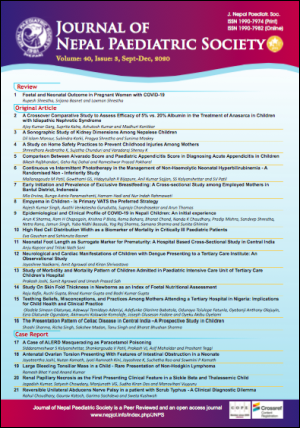Study On Skin Fold Thickness in Newborns as an Index of Foetal Nutritional Assessment
DOI:
https://doi.org/10.3126/jnps.v40i3.29517Keywords:
CAN score, Foetal malnutrition, Skin fold thicknessAbstract
Introduction: Skin fold thickness is a measure of adiposity and is a validated method of assessing malnutrition in older children. The present study was undertaken to see the role of skin fold thickness measurement in neonates as an index of foetal nutritional assessment and to compare between CAN (Clinical Assessment of Nutrition) score and other anthropometric indicators in foetal malnutrition (FM).
Methods: A prospective observational study was conducted in postnatal ward of Universal College of Medical Sciences-Teaching Hospital for a duration of six months. Three hundred seventy term newborns were assessed by CAN score and anthropometry recorded. The CAN score was determined and those with scores < 25 was classified as having foetal malnutrition. Skin fold thickness using the Slim Guide skin fold caliper was taken at the triceps, biceps, sub scapular, supra iliac and quadriceps locations for each neonate. Two readings were taken at every site and the mean was recorded. All the skin fold thickness measurements were correlated with the CAN score and statistical comparisons were made.
Results: Incidence of FM was 18.38%. The mean (SD) for sum of all skin-fold thickness at all sites for males and females were 4.3 ± 1.61 and 4.18 ± 0.72 mm respectively. All the skin-fold thickness measurements correlated significantly with the CAN score, but the sum of the five had the best correlation. The mean (SD) of anthropometric data of babies and sum of all comparing foetal malnutrition versus without foetal malnutrition using nutritional status CAN score was statistically significant (p-value < 0.001).
Conclusions: The sum of all five skin-fold measurements might be a useful screening tool for FM in view of its objectivity, convenience and simplicity, but it is not sufficiently sensitive or specific to replace the CAN score in the identification of FM in neonates.
Downloads
Downloads
Published
How to Cite
Issue
Section
License
Authors who publish with this journal agree to the following terms:
Authors retain copyright and grant the journal right of first publication with the work simultaneously licensed under a Creative Commons Attribution License that allows others to share the work with an acknowledgement of the work's authorship and initial publication in this journal.
Authors are able to enter into separate, additional contractual arrangements for the non-exclusive distribution of the journal's published version of the work (e.g., post it to an institutional repository or publish it in a book), with an acknowledgement of its initial publication in this journal.
Authors are permitted and encouraged to post their work online (e.g., in institutional repositories or on their website) prior to and during the submission process, as it can lead to productive exchanges, as well as earlier and greater citation of published work (See The Effect of Open Access).



